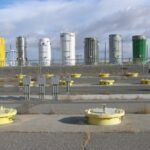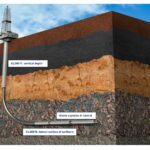Advanced nuclear energy can, and should, play a major role in meeting the societal goal of 100% clean energy by mid-century. Advanced nuclear energy would complement other energy sources like wind and solar, providing firm clean energy to supply electricity, industrial heat, hydrogen, and other important energy products. Deploying advanced nuclear energy as part of the climate solution, however, will also require managing wastes produced during operation.
COMMENTARY
While the total amount of waste from advanced nuclear energy will be very small relative to the total amount of energy produced, safe waste management is critical to protect public health as well as build public trust and social license for advanced nuclear energy. Increasing interest in innovative advanced nuclear technology as a climate solution has also renewed interest in developing innovative nuclear waste solutions, including methods to reduce waste volumes and radiotoxicity, and enable more effective disposal.
Discussing innovative nuclear waste solutions first requires an understanding of what nuclear waste actually is. Nuclear waste is classified based on where it came from and its radioactivity. The two main types are high-level waste (HLW) and low-level waste (LLW). HLW consists of the used nuclear fuel and byproducts that require long-term separation from society in deep geological disposal facilities. LLW consists of all other wastes that are contaminated with radioactive materials, such as workers’ used gloves or components that filter out radioactive material from reactor systems. LLW is generally less radioactive than HLW and can already safely be disposed of in surface-level disposal facilities.
Innovative design and policy solutions currently under development could help advanced reactors produce less HLW and LLW, and create new pathways to dispose of existing and future HLW. Developing new methods to reduce the total volume of HLW from nuclear energy production would reduce the size requirements for deep geological disposal facilities. Deployment of certain advanced reactor designs (such as fast-neutron spectrum reactors) could enable more efficient fuel utilization, enabling more power production from each nuclear fuel assembly and reducing the total amount of HLW produced.
Alternatively, deploying fuel recycling or reprocessing technologies could enable separation of highly radioactive fission products from usable uranium in used nuclear fuel. These fission products, normally less than 5% of the used fuel, could then be separately stored as HLW with the remaining used fuel available for recycling into new nuclear fuel. These technology solutions would enable greater utilization of uranium resources and reduce the volume of HLW for long-term disposal.
Reducing the radiotoxicity of nuclear power plant waste by design can reduce challenges of HLW disposal. Certain advanced reactor designs and fuel cycles can transmute specific types of highly radioactive HLW with extremely long half-lives (specifically transuranic isotopes) into LLW with much shorter half-lives by exposing it to high levels of neutron radiation. These designs could produce waste that is radioactive for much shorter periods of time—thousands of years instead of hundreds of thousands of years—and would significantly simplify the design and siting requirements for HLW deep geological disposal facilities.
Creating new disposal solutions could also reduce the social burden of HLW management. One innovative technical solution for HLW disposal is the use of deep geologic boreholes. HLW has historically been slated for disposal in a small number of large mined geologic repositories. Siting, constructing, and operating a small number of large repositories is challenging both politically and technically. Deep borehole technology would use advanced drilling techniques to distribute HLW deep underground across a larger number of boreholes, reducing the burden on any one community. These boreholes could be easier to site and can be placed much deeper underground than mined repositories.
In all cases, the use of consent-based siting processes should be implemented to ensure that we don’t place the burden of long-term waste management on communities that don’t understand, approve of, or benefit from the waste disposal facility. These consent-based siting practices may require additional political and social engagement, but building community trust is critical to ensuring development of durable, long-term solutions to waste management.
These technology and policy innovations are at varying levels of technology maturity but each could have a positive impact on management and disposal of nuclear waste. Continuing support is needed to help develop these technologies and assess both their technical viability and potential impact on waste management and disposal. Ongoing Department of Energy programs, such as ONWARDS, are a first step in early-stage research and development for these technologies. We will also need to determine what policy, economic, and social incentives can drive adoption and deployment of sensible waste solutions.
Companies, policymakers, stakeholders, and communities need to work together to manage advanced nuclear energy waste. New technology and policy solutions to nuclear waste could further reduce the burden on communities, society, and the environment. Managing and disposing of the wastes produced by advanced nuclear energy is important to protect public health, and in developing public trust and social license for advanced nuclear energy deployment as part of the climate solution.
—Patrick White, PhD is a project manager at the Nuclear Innovation Alliance (NIA) where he leads NIA’s research and advocacy related to advanced reactor licensing strategies, regulatory modernization, and nuclear fuel cycles.











